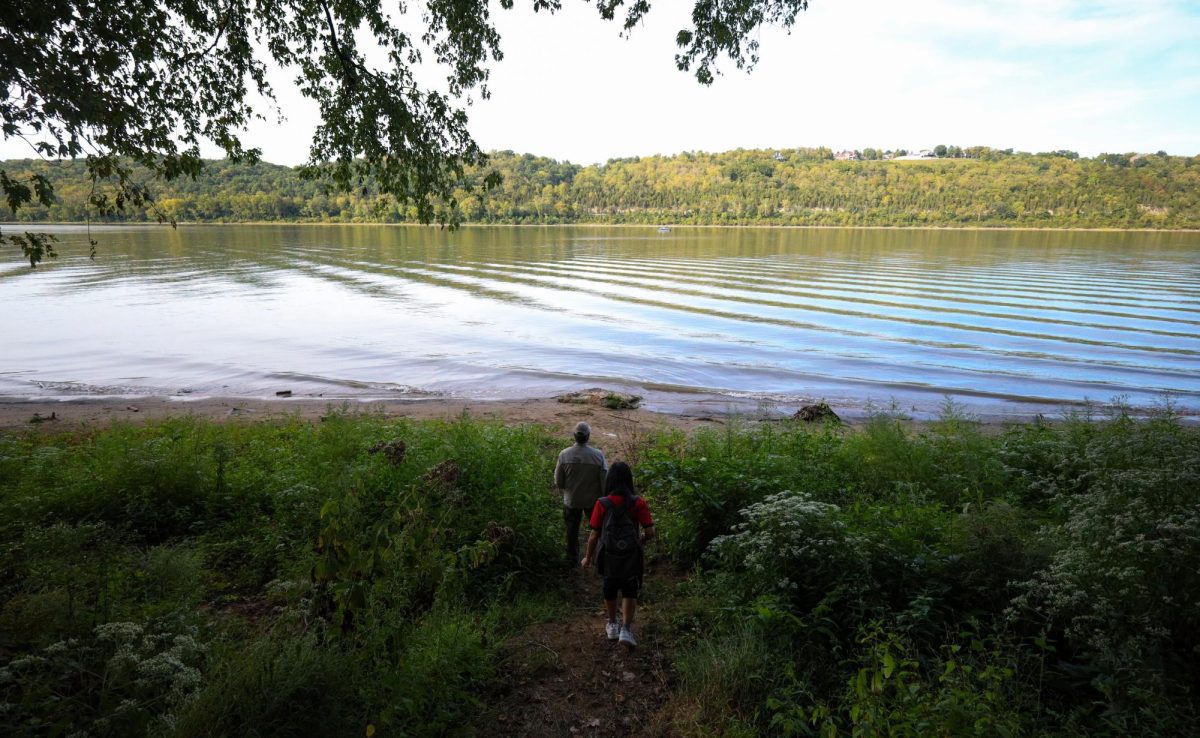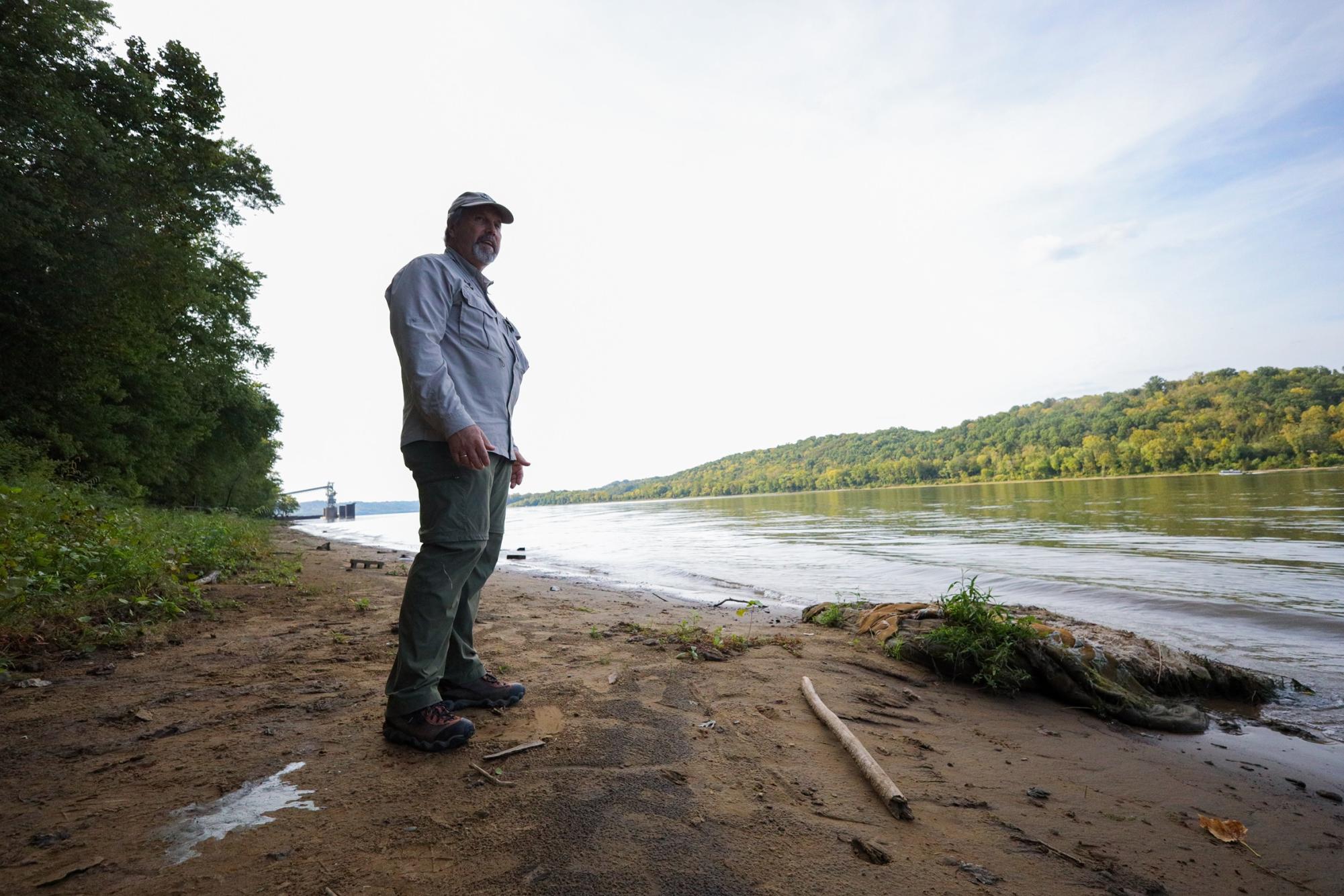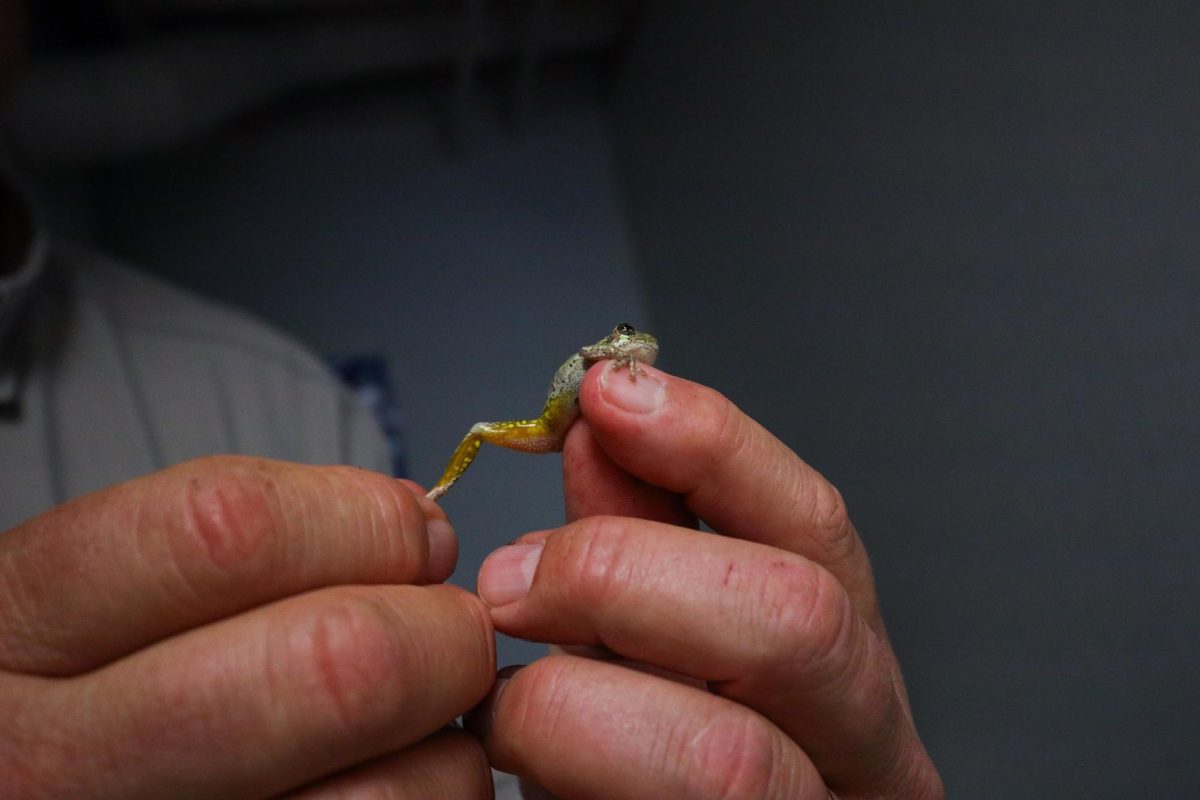Dr. Richard Durtsche unhooked a black forearm-length tube from a tree trunk, pressed its circular opening against the palm of his hand. He shook the tube lightly, but nothing came out. So he moved on, checking another tube along the trail to see if any tree frog had taken up residence inside.
The frogs and salamanders climb into the tubes for protection from predators during the day and climb out at night. Such simple contraptions also provide easy sampling specimens for Durtsche and his students, who measure and mark the animals before releasing them into the wild again.
Similar trapping stations are scattered across Northern Kentucky University’s Research and Educational Field Station, acronymed REFS, located on 155 acres of almost-pristine wilderness tucked into the town of Melbourne, Kentucky, so close to the Ohio River that visitors can stand on the tiny strip of sandy shore and let water lap at their feet.
The land originally belonged to the local St. Anne Convent, home to the American Province of the Congregation of Divine Providence. To this day it still bears the convent’s name as St. Anne Woods and Wetlands. The order sold it to the Campbell County Conservation District in 2013 because they needed money to build a retirement home for their Roman Catholic nuns, Durtsche explained.
He has been conducting research in the area since 2001. In 2008, he and fellow NKU faculty member Becky Evans received a university grant to build a trail system meant for environmental education on these acres, the borders of which are marked by the Ohio and a railway just beyond a drywall factory.
After acquiring the land, Campbell County submitted a grant application to the Kentucky Natural Heritage Conservation Fund, which used money from the sales of nature license plates, mineral tax and fines on coal companies to turn the land into a conservation easement, Durtsche said, immediately barring it from development. The field station officially opened to the public in 2017.
Before the designation took effect, however, Durtsche and community partners sought the help of an expert in wetlands restoration, who deployed excavators to create a series of ponds: depressions in the ground of varying depths that would hold water in the spring and dry out in the summer, known as ephemeral or vernal ponds. Too short-lived to sustain fish communities, these ponds are preferred by insects and amphibians as they do not have to face predators.
On a late September day, Durtsche navigated one of the publicly accessible trails that wind through the dried wetlands, pointing out three soft, spongelike earthen beds where the ephemeral ponds lie, nestled behind outgrowths of bushes and tallgrasses. The deepest pond still has a little water left in it, dull and stagnant beneath the sun.
“See if you see movement,” Durtsche instructed as he moved closer to the pond’s edge. Something jumped in the water covered in algae, quick as a flash. “Those are all tadpoles,” he said—specifically, green frog or bullfrog tadpoles, which dwell in the ponds for up to two years until they metamorph into adult frogs.
Frogs comprise a fraction of the creatures that Durtsche, students and other researchers study at the field station. Seven species of frogs and four species of salamanders call these wetlands home, along with turtles, rabbits, red and gray foxes, deer, coyotes, raccoons, muskrats, beavers, wild birds and a whole lot of insects.
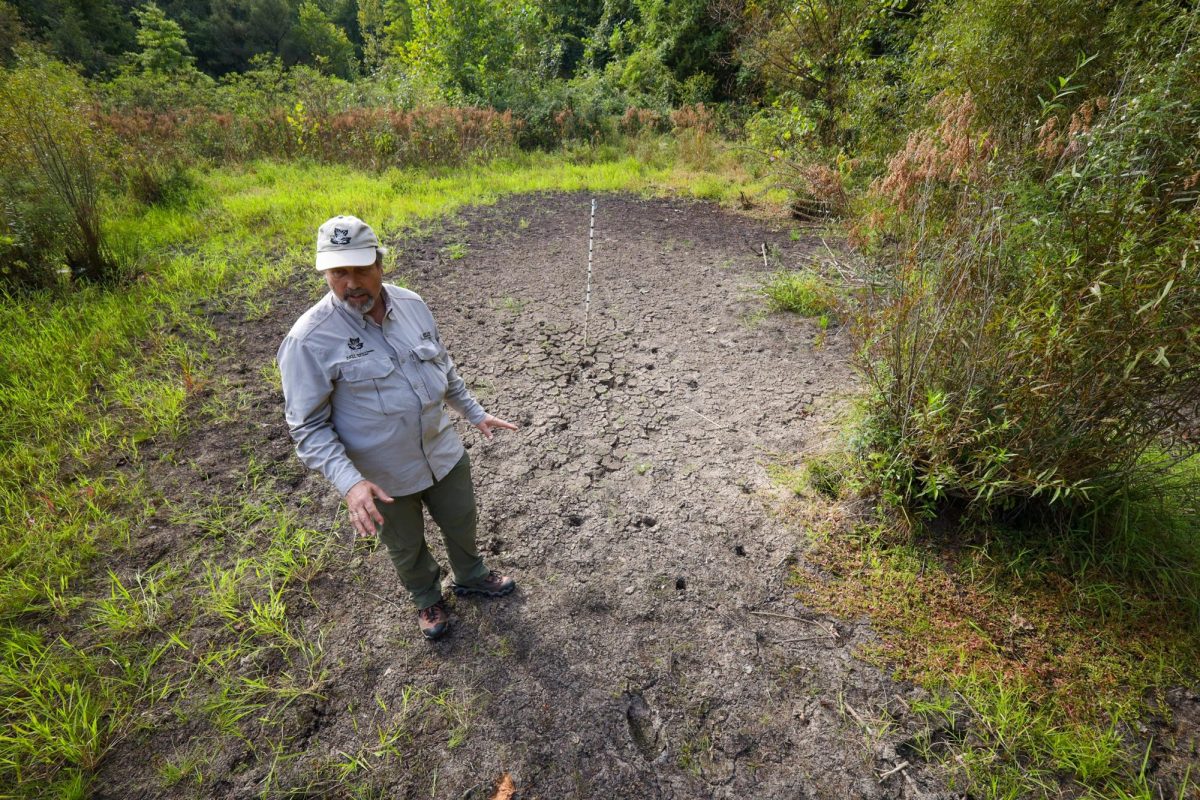
For one educational program at REFS, middle school students walk the trails and collect animals from the trapping stations. In addition to the tree tubes, amphibians can be found underneath round pieces of log—“wood cookies,” as Durtsche calls them—strategically placed to attract animals that want to keep themselves hydrated through the day. A hidden netting fence skirts the ponds, sifting aquatic animals into buckets underneath when the water rises. A corrugated metal sheet lies flat on the ground: Durtsche lifted it by the corner to check if a local water snake had come to visit again.
After sampling these catches, students create artworks depicting their experience. They also learn to read the journals of naturalists, biological researchers from past times who kept detailed accounts and vivid illustrations of their expeditions in the wild, and write their own descriptions of the wetlands. These activities add the components of art, reading and writing to a Science, Technology, Engineering and Mathematics education, creating the only S.T.R.E.A.M. program that Durtsche knows of in the region.
Not only for school children, REFS offers fieldwork opportunities in 19 courses across seven disciplines for university students, along with a micro-credential in wetland management and long-term scientific research. Tate Judge, a NKU student and technician at the station, is studying the variations in bird calls across different species. Dr. Allison Parker, an environmental science professor, is investigating conditions that nourish disease-transmitting insects like wood ticks and mosquitos.
Dr. Yingying Xie, assistant professor in biological sciences, is collaborating with Dr. Durtsche and REFS Assistant Director Dr. Richard Boyce on a project that addresses the question: how do earlier plant activities, caused by warming in spring, affect the availability of water in ephemeral ponds and, in turn, impact amphibians that rely on the water for reproduction? The study is part of the EREN Vernal Pool Phenology project.
The study facilities on site are small, concentrated and reasonably equipped. The road to REFS terminates in a small two-story building in a grassy clearing: the first floor features a compact kitchen and dining area, cabinets displaying REFS-branded merchandise, basic measurement tools and a mossy terrarium for select tadpoles and amphibians.
In the shadow of the terrarium’s ambience, Durtsche scooped up from a glass container an eastern box turtle—a male individual, as indicated by the bright orange patterns on his limbs. When he tried to hold up a nearby Cope’s gray tree frog, the tiny animal leapt repeatedly between the container and his fingers.
After putting the animals away, Durtsche ascended an outdoor staircase to the upper floor and opened the door into a research and presentation space, complete with an industrial-grade metal table for experiments, presentation boards and researcher rooms. Durtsche describes himself as a herpetologist, someone who studies amphibians and reptiles, with a special interest in physiological ecology or how animals respond physiologically to environmental changes. He has published research on the effects of climate change via increasing water temperatures on the metabolism of Kentucky freshwater fish, and the effects of the invasive honeysuckle on native amphibian and reptile populations.
Invasive species abound with a stranglehold in the area. Honeysuckles with their white blooms can be found near almost every body of water in the Ohio River Valley, and along the trail Durtsche paused to inspect a dry, thorny vine that blended seamlessly into the green background. “That’s the multiflora rose,” he said, an invasive plant with a hard, rounded stem and easy to confuse with the squared-stem blackberry, a native plant.
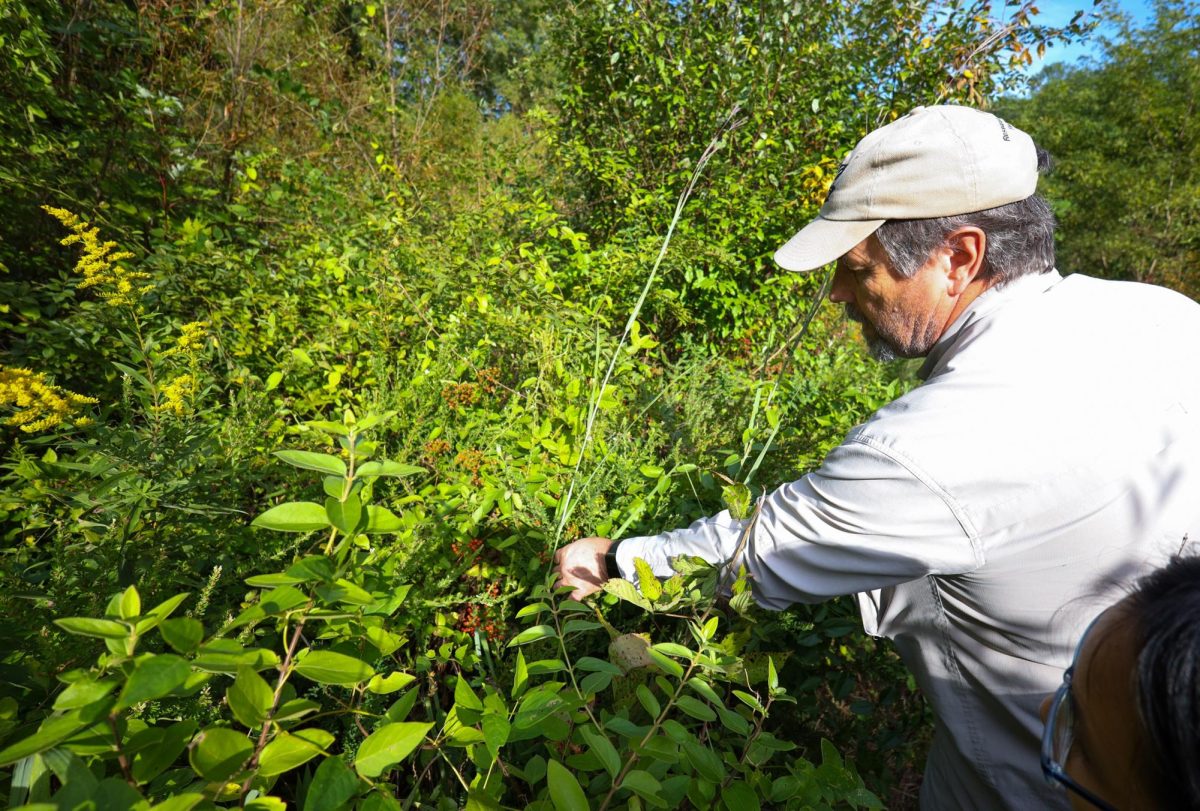
The professor makes no claim to being a botanist, however—that distinction goes to Dr. Boyce, who is studying the leaf blight fungus that infects honeysuckle leaves and how it can be used as a natural controlling agent.
Like many young people, Durtsche’s biological interests started with dinosaurs, which quickly graduated to reptiles and amphibians. “My parents were kind of against it; they thought I should do something different,” he said. But he was driven in his pursuit, and as an outdoors person, he only found more inspiration after taking biology classes in college.
Now, he is organizing educational programs that might yet inspire a new generation of biology enthusiasts. The field station routinely hosts community engagement events such as hikes, walk-and-talks with experts and summer camps, but its biggest event is the Nature Adventure Day. Held at the end of every September—Sept. 30 this year—the event invites all members of the public, young and old, to venture out in the wild and participate in a slate of fun activities from turtle races to birdfeeder building.
“Last year we had the Melbourne Fire Department come down with one of their trucks and they showed us how the trucks functioned,” Durtsche recalled. Local firefighters are deployed to contain any fire that might break out on conservation grounds.
But at other times of year St. Anne Woods and Wetlands lie quiet, relatively untouched by humans except for the researchers and students who walk the trails to make routine inspections of the trapping and observation stations. For the project with Dr. Xie, Durtsche and his student Alex Walsh keep track of amphibians captured from spring to fall, with the professor recording the calling of frogs during breeding season.
Timelapse cameras stand hidden amidst the flora as they take hourly photos of the ponds. A pole with built-in electronic sensors protrudes like a pillar from the bed of the deepest pond, but it measures water levels that change with the seasons. And on a side of the trail, a rustic-looking weather station diligently records air temperatures.
“We have set up eight sites at REFS so far and will continue our observations for multiple years,” Xie said, with plans for more observations in the future.
Tucked into a corner of Northern Kentucky, so close to the Ohio River that domestic waste regularly washes ashore, the hidden world of St. Anne is large. Large enough to nurture the curiosity of students from preschool to grad school, to accommodate visitors seeking knowledge or relaxation in the wild, to open itself to scientists observing nature’s response to climate change—and still it will have something to offer, through the seasons and the years, always.
